Maintaining Safe Practices in Phlebotomy: Risks and Impact on Health Outcomes
Added on 2023-01-03
35 Pages12212 Words1 Views
Dissertation
1
1

Executive Summary
Phlebotomy refers to the technique where a needle is inserted temporarily into a vein in
order to administer venous access for the blood sampling. Through this process, puncture is
made in a vein of arm with cannula with the aim of drawing blood. For the identification of
appropriate site for venous exercise, both tactile and visually evaluations are involved. This
study aims to perform an investigation on role of maintaining safe practices in minimising errors
during the process of phlebotomy along with its adverse impact on health outcomes. The report
explores the potential risks which arise during the process of phlebotomy for patients and lab
technician. These risks involve nerve damage, allergic reactions, back strain, physical injuries,
exposure to body fluids, infection, hemoconcentration, hematoma formation etc. All these are the
potential risks which could arise during the process of venipuncture.
Apart from this, using safe practices during the process will help in minimising risk and
enhancing the clinical outcomes. There are several ways through which safe sharp practices can
be maintained in the procedure of phlebotomy. The practices involve awareness raising,
provision of safety engineer devices, safe use and disposal of needles, elimination of unnecessary
needles, reporting and recording, education and training response and follow up etc. All these are
the appropriate ways through which safe practices can be maintained. In addition to this, it is
necessary for the lab technicians to use well-fitting gloves and take care of hand hygiene during,
after and before performing the process of phlebotomy. This study provides detail knowledge
and information on the topic and will help the scholars in carrying out further study on the
similar topic or the topic associated with it.
2
Phlebotomy refers to the technique where a needle is inserted temporarily into a vein in
order to administer venous access for the blood sampling. Through this process, puncture is
made in a vein of arm with cannula with the aim of drawing blood. For the identification of
appropriate site for venous exercise, both tactile and visually evaluations are involved. This
study aims to perform an investigation on role of maintaining safe practices in minimising errors
during the process of phlebotomy along with its adverse impact on health outcomes. The report
explores the potential risks which arise during the process of phlebotomy for patients and lab
technician. These risks involve nerve damage, allergic reactions, back strain, physical injuries,
exposure to body fluids, infection, hemoconcentration, hematoma formation etc. All these are the
potential risks which could arise during the process of venipuncture.
Apart from this, using safe practices during the process will help in minimising risk and
enhancing the clinical outcomes. There are several ways through which safe sharp practices can
be maintained in the procedure of phlebotomy. The practices involve awareness raising,
provision of safety engineer devices, safe use and disposal of needles, elimination of unnecessary
needles, reporting and recording, education and training response and follow up etc. All these are
the appropriate ways through which safe practices can be maintained. In addition to this, it is
necessary for the lab technicians to use well-fitting gloves and take care of hand hygiene during,
after and before performing the process of phlebotomy. This study provides detail knowledge
and information on the topic and will help the scholars in carrying out further study on the
similar topic or the topic associated with it.
2
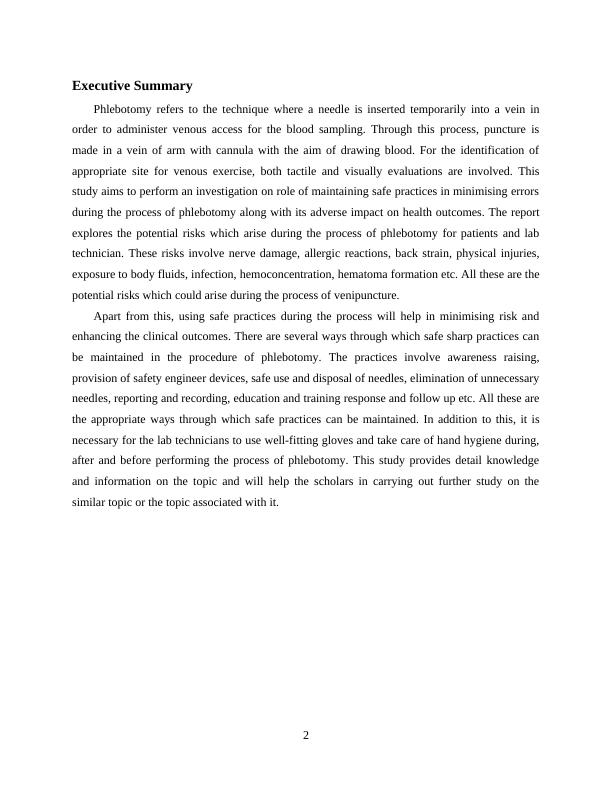
Contents
Dissertation......................................................................................................................................1
Executive Summary.........................................................................................................................2
TITLE: “An Investigation into maintaining safe practices amongst lab technicians during
phlebotomy”.....................................................................................................................................4
1.0 Introduction and Background....................................................................................................4
2.0 Problem and Justification...........................................................................................................5
3.0 Objectives..................................................................................................................................6
4.0 Literature Review.......................................................................................................................7
4.1 Potential risks that could arise during phlebotomy for both lab technicians and patients7
4.2 Effectiveness of safe practices in reducing risks and improving clinical outcomes during
phlebotomy...........................................................................................................................10
4.3 Ways of integrating and maintaining safe sharp practices in phlebotomy procedure....13
5.0 Methodology............................................................................................................................17
6.0 Study Overview.......................................................................................................................23
6.1 Inclusion criteria......................................................................................................................24
6.2 Exclusion criteria.....................................................................................................................24
6.3 Timescales................................................................................................................................24
6.4 Ethical Considerations.............................................................................................................26
6.5 Outcomes.................................................................................................................................26
6.6 Intervention..............................................................................................................................26
6.7 Data Extract.............................................................................................................................27
7.0 Conclusion...............................................................................................................................28
REFERENCES..............................................................................................................................30
3
Dissertation......................................................................................................................................1
Executive Summary.........................................................................................................................2
TITLE: “An Investigation into maintaining safe practices amongst lab technicians during
phlebotomy”.....................................................................................................................................4
1.0 Introduction and Background....................................................................................................4
2.0 Problem and Justification...........................................................................................................5
3.0 Objectives..................................................................................................................................6
4.0 Literature Review.......................................................................................................................7
4.1 Potential risks that could arise during phlebotomy for both lab technicians and patients7
4.2 Effectiveness of safe practices in reducing risks and improving clinical outcomes during
phlebotomy...........................................................................................................................10
4.3 Ways of integrating and maintaining safe sharp practices in phlebotomy procedure....13
5.0 Methodology............................................................................................................................17
6.0 Study Overview.......................................................................................................................23
6.1 Inclusion criteria......................................................................................................................24
6.2 Exclusion criteria.....................................................................................................................24
6.3 Timescales................................................................................................................................24
6.4 Ethical Considerations.............................................................................................................26
6.5 Outcomes.................................................................................................................................26
6.6 Intervention..............................................................................................................................26
6.7 Data Extract.............................................................................................................................27
7.0 Conclusion...............................................................................................................................28
REFERENCES..............................................................................................................................30
3
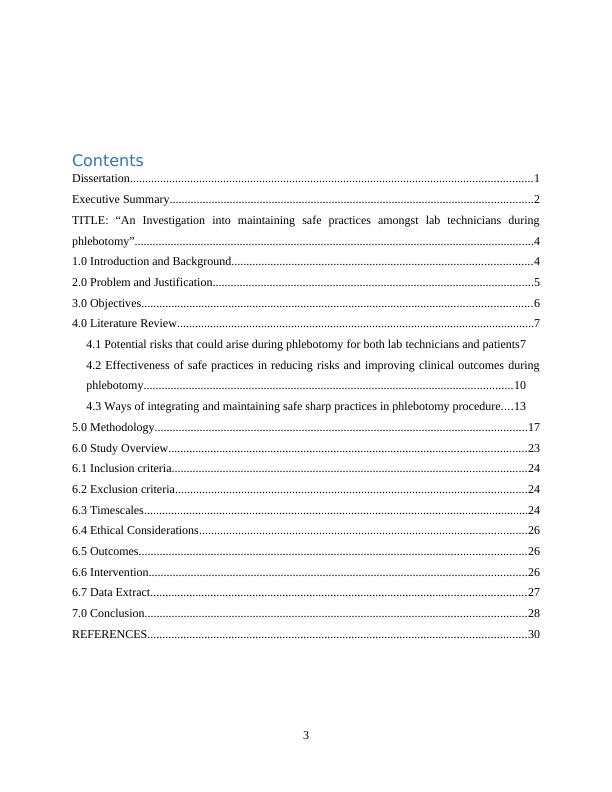
4

TITLE: “An Investigation into maintaining safe practices amongst lab
technicians during phlebotomy”
1.0 Introduction and Background
Phlebotomy is referred as the process of making a puncture in vein, with the cannula in
order to draw blood. This procedure is known as venipuncture that is also utilised for intravenous
therapy. It has practiced from centuries and is still one of the common invasive procedure within
the health care settings. In the technique of phlebotomy, needle is inserted temporarily into a
vein in order to administer venous access for blood sampling. The veins have 3 layered wall
which is composed of intrinsic endothelium surrounded through thin layer of muscle fibres, that
in turn surrounded through connective tissue layer. Therapeutic phlebotomy is one among the
preferred treatment for blood related disorders where removal of serum iron or red blood cells is
an efficient method for managing the symptoms as well as complications in an effective way. If
the blood sample is collected poorly, then the outcome may be inaccurate as well as mislead to
the clinician and the person who give the sample may have to undergo inconvenience of repeat
testing. Maintaining safe practices among the lab technicians during phlebotomy is very
necessary in order to collect blood sample safely. The lab technicians are expected to maintain
high hygiene level to negate the vulnerability of patient as well as themselves towards potential
diseases and infection.
In modern health care settings, the safety of patient is considered as priority and it is very
necessary to take care of it during the nursing care. Avoiding the injury of patient and
administering them with best possible care is a constant struggle. The results of laboratory test
following phlebotomy constitute main cornerstone in diagnosis as well as treatment of patient.
The errors in phlebotomy might cause delay in diagnosis, sampling erroneous treatment. The
errors jeopardise the health and safety of patients. Lab safety is a critical and significant element
to the success of medical laboratory. The biosafety practices of professionals are influenced by
chemical, biological, electrical, radiological and fire hazards. The common threats to the safety
of laboratory involves improper utilisation of personal protective equipment, improper utilisation
of biological safety cabinets appropriate to work, potential technician exposure and failure in
following protocols for proper chemical hygiene plan.
5
technicians during phlebotomy”
1.0 Introduction and Background
Phlebotomy is referred as the process of making a puncture in vein, with the cannula in
order to draw blood. This procedure is known as venipuncture that is also utilised for intravenous
therapy. It has practiced from centuries and is still one of the common invasive procedure within
the health care settings. In the technique of phlebotomy, needle is inserted temporarily into a
vein in order to administer venous access for blood sampling. The veins have 3 layered wall
which is composed of intrinsic endothelium surrounded through thin layer of muscle fibres, that
in turn surrounded through connective tissue layer. Therapeutic phlebotomy is one among the
preferred treatment for blood related disorders where removal of serum iron or red blood cells is
an efficient method for managing the symptoms as well as complications in an effective way. If
the blood sample is collected poorly, then the outcome may be inaccurate as well as mislead to
the clinician and the person who give the sample may have to undergo inconvenience of repeat
testing. Maintaining safe practices among the lab technicians during phlebotomy is very
necessary in order to collect blood sample safely. The lab technicians are expected to maintain
high hygiene level to negate the vulnerability of patient as well as themselves towards potential
diseases and infection.
In modern health care settings, the safety of patient is considered as priority and it is very
necessary to take care of it during the nursing care. Avoiding the injury of patient and
administering them with best possible care is a constant struggle. The results of laboratory test
following phlebotomy constitute main cornerstone in diagnosis as well as treatment of patient.
The errors in phlebotomy might cause delay in diagnosis, sampling erroneous treatment. The
errors jeopardise the health and safety of patients. Lab safety is a critical and significant element
to the success of medical laboratory. The biosafety practices of professionals are influenced by
chemical, biological, electrical, radiological and fire hazards. The common threats to the safety
of laboratory involves improper utilisation of personal protective equipment, improper utilisation
of biological safety cabinets appropriate to work, potential technician exposure and failure in
following protocols for proper chemical hygiene plan.
5
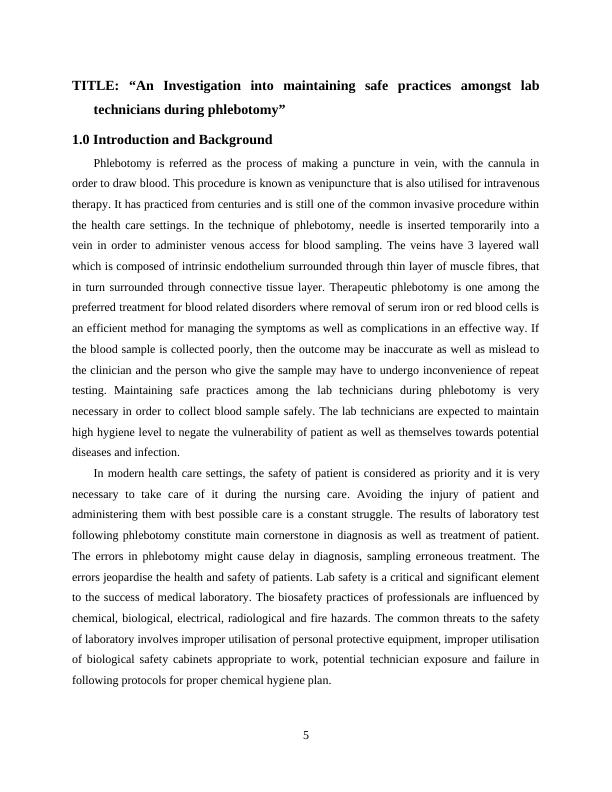
Ensuring a safe environment of laboratory is the key responsibility of laboratory personnel
management of healthcare institution. Laboratory safety is not purely voluntary function, but
needs mandatory safety rules as well as programs along with the ongoing commitment. Direct
responsibility for administration of laboratory safety program rests with safety director or
chemical hygiene officer. Laboratory instructors perform direct responsibility for the actions
taken by other people. They are responsible for promoting safety culture and inform them about
requisite knowledge and skills needed for handling the chemical safety. The main duties of lab
technician include receiving, processing as well as analysing the samples. Relying on the work
setting, samples may include tissue and blood, chemical product etc. Apart from this, performing
test; using, cleaning and maintaining different types of equipment; handling compressed gas
cylinders; handling chemicals as well as other materials; and administrative tasks like
documenting procedures, maintaining notebooks and preparing invoices and orders are all the
responsibilities of lab technician.
Research Question:
Research question is stated as a question which is set out in the research project to answer.
Selecting a question of research is crucial element of qualitative and quantitative research as
well. It requires data collection and analysis along with the methodology for this will vary
broadly. A good question of study seeks to enhance the knowledge on significant topic and is
usually specific and narrow. The research question in context of this study is “How safe practices
can be maintained amongst lab technicians during phlebotomy to reduce errors in health
outcomes?”
Hypothesis:
“Negligence of maintaining safe practices during phlebotomy result in laboratory errors and
delay in diagnosing diseases”.
2.0 Problem and Justification
This particular research study is based on the topic “An Investigation into maintaining safe
practices amongst lab technicians during phlebotomy” and it aims to carry out investigation on
role of maintaining safe practices in reducing errors during phlebotomy and its adverse impact on
health outcomes. The main reason of selecting this study is that phlebotomy is the procedure in
which the risk of infection is high for lab technicians. By performing this study, the ways to
maintain safe practices can be determining so that health outcomes will be improved. This study
6
management of healthcare institution. Laboratory safety is not purely voluntary function, but
needs mandatory safety rules as well as programs along with the ongoing commitment. Direct
responsibility for administration of laboratory safety program rests with safety director or
chemical hygiene officer. Laboratory instructors perform direct responsibility for the actions
taken by other people. They are responsible for promoting safety culture and inform them about
requisite knowledge and skills needed for handling the chemical safety. The main duties of lab
technician include receiving, processing as well as analysing the samples. Relying on the work
setting, samples may include tissue and blood, chemical product etc. Apart from this, performing
test; using, cleaning and maintaining different types of equipment; handling compressed gas
cylinders; handling chemicals as well as other materials; and administrative tasks like
documenting procedures, maintaining notebooks and preparing invoices and orders are all the
responsibilities of lab technician.
Research Question:
Research question is stated as a question which is set out in the research project to answer.
Selecting a question of research is crucial element of qualitative and quantitative research as
well. It requires data collection and analysis along with the methodology for this will vary
broadly. A good question of study seeks to enhance the knowledge on significant topic and is
usually specific and narrow. The research question in context of this study is “How safe practices
can be maintained amongst lab technicians during phlebotomy to reduce errors in health
outcomes?”
Hypothesis:
“Negligence of maintaining safe practices during phlebotomy result in laboratory errors and
delay in diagnosing diseases”.
2.0 Problem and Justification
This particular research study is based on the topic “An Investigation into maintaining safe
practices amongst lab technicians during phlebotomy” and it aims to carry out investigation on
role of maintaining safe practices in reducing errors during phlebotomy and its adverse impact on
health outcomes. The main reason of selecting this study is that phlebotomy is the procedure in
which the risk of infection is high for lab technicians. By performing this study, the ways to
maintain safe practices can be determining so that health outcomes will be improved. This study
6

is significant as it assists researcher in exploring the potential risks which may arise at the time
of performing phlebotomy process. It also helps in determining the effectiveness of safe practices
in minimising risk and enhancing clinical outcomes during the process. Apart from this, study
analyses the way of integrating and maintaining safe practices in the phlebotomy procedure
which further help the lab technicians in preventing themselves as well as the patient from injury
from sharps and needles and infections associated with blood borne pathogens. This is study
provides deep insights on the topic to investigator and help in enhancing their knowledge. With
the help of this study, researcher get knowledge about other areas also which are associated to
the topic.
3.0 Objectives
Research Aim:
Research aim defines the aspiration or intention of study and summarises in single sentence
what the researcher hope to accomplish in the end of the research study. The aim of the study is
usually written in broad terms and is set out to show what the project hope to achieve in the end.
The aim associated with this particular study is “To carry out investigation on role of
maintaining safe practices in reducing errors during phlebotomy and its adverse impact on health
outcomes”.
Research Objectives:
Research objective is defined as the goal of a research that describes what the researcher
expect to accomplish through the project. They are linked to the hypothesis or utilized as
statement of purpose in the research which does not have hypothesis. The objectives are the
actions that will take to accomplish the aim of the study and provide direction to investigator to
perform the study systematically. The objectives associated with this particular study are as
follows:
1. To explore the potential risks that could arise during phlebotomy for both lab technicians
and patients.
2. To determine the effectiveness of safe practices in reducing risks and improving clinical
outcomes during phlebotomy.
3. To analyse the ways of integrating and maintaining safe sharp practices in phlebotomy
procedure.
7
of performing phlebotomy process. It also helps in determining the effectiveness of safe practices
in minimising risk and enhancing clinical outcomes during the process. Apart from this, study
analyses the way of integrating and maintaining safe practices in the phlebotomy procedure
which further help the lab technicians in preventing themselves as well as the patient from injury
from sharps and needles and infections associated with blood borne pathogens. This is study
provides deep insights on the topic to investigator and help in enhancing their knowledge. With
the help of this study, researcher get knowledge about other areas also which are associated to
the topic.
3.0 Objectives
Research Aim:
Research aim defines the aspiration or intention of study and summarises in single sentence
what the researcher hope to accomplish in the end of the research study. The aim of the study is
usually written in broad terms and is set out to show what the project hope to achieve in the end.
The aim associated with this particular study is “To carry out investigation on role of
maintaining safe practices in reducing errors during phlebotomy and its adverse impact on health
outcomes”.
Research Objectives:
Research objective is defined as the goal of a research that describes what the researcher
expect to accomplish through the project. They are linked to the hypothesis or utilized as
statement of purpose in the research which does not have hypothesis. The objectives are the
actions that will take to accomplish the aim of the study and provide direction to investigator to
perform the study systematically. The objectives associated with this particular study are as
follows:
1. To explore the potential risks that could arise during phlebotomy for both lab technicians
and patients.
2. To determine the effectiveness of safe practices in reducing risks and improving clinical
outcomes during phlebotomy.
3. To analyse the ways of integrating and maintaining safe sharp practices in phlebotomy
procedure.
7
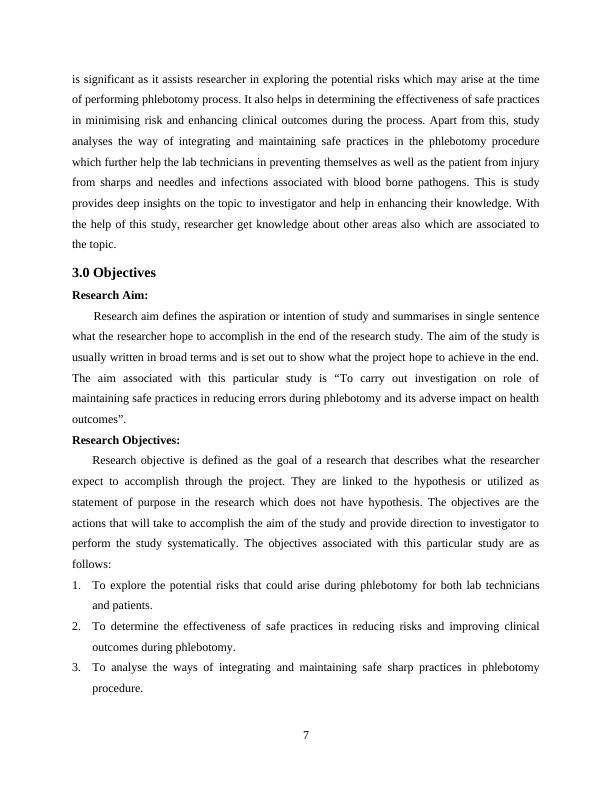
4.0 Literature Review
4.1 Potential risks that could arise during phlebotomy for both lab technicians and patients
As per the view point of Omiepirisa Yvonne Buowari, (2013), phlebotomy is the most
common procedure which is performed within health care settings. Whenever phlebotomy is
performed, early detection and effective communication between healthcare provider and patient
is very important in order to prevent serious complications. It is the act in which the vein is
puncturing for removal of blood or giving a drug. The process has been practiced from centuries
and is still a common invasive procedure. The process must be performed with proper care in
order to protect the patient as well as the health care provider. Before starting the procedure, it is
very necessary to determine the patient accurately (What Are Some of the Dangers of Being a
Phlebotomist? 2020). The key source of specimen for testing the medication and the site for
blood transfusion and intravenous infusion are the veins of patient as there are limited number of
veins which are easily accessible in patient. It is significant that everything will be done to
preserve their good condition as well as availability. there are many potential risks which could
arise during the process of phlebotomy for the patients as well as lab technicians. Some of the
complications are discussed below:
1. Hematoma formation: this is a common type of complication which is caused due to
leaking of blood into tissue at the time of performing phlebotomy or after phlebotomy. A
common symptom of this complication is swelling at or near the site of venepuncture. It
can occur as minor complication of phlebotomy. Adjacent to the site of puncture, the
haematoma forms under the skin and when it occurs, it releases the tourniquet
immediately, withdraw needle as well as apply firm pressure. It occurs when the area
surrounding puncture site initiates to swell, this indicates that blood is leaking into tissue
which will out come in a bruise because of partial insertion into vein. If hematoma starts
to form when blood is being withdrawn, it is necessary for lab technician to remove the
middle immediately as well as pressure maintained over the site. The main causes of
hematoma formation after phlebotomy are excessive probing for finding vein, fragile
veins, removing needle prior to release tourniquet, too large needle, applying pressure to
gauze the needle before it is removed, needle entering partially into the vein allowing
leakage and needle going all way through the vein.
8
4.1 Potential risks that could arise during phlebotomy for both lab technicians and patients
As per the view point of Omiepirisa Yvonne Buowari, (2013), phlebotomy is the most
common procedure which is performed within health care settings. Whenever phlebotomy is
performed, early detection and effective communication between healthcare provider and patient
is very important in order to prevent serious complications. It is the act in which the vein is
puncturing for removal of blood or giving a drug. The process has been practiced from centuries
and is still a common invasive procedure. The process must be performed with proper care in
order to protect the patient as well as the health care provider. Before starting the procedure, it is
very necessary to determine the patient accurately (What Are Some of the Dangers of Being a
Phlebotomist? 2020). The key source of specimen for testing the medication and the site for
blood transfusion and intravenous infusion are the veins of patient as there are limited number of
veins which are easily accessible in patient. It is significant that everything will be done to
preserve their good condition as well as availability. there are many potential risks which could
arise during the process of phlebotomy for the patients as well as lab technicians. Some of the
complications are discussed below:
1. Hematoma formation: this is a common type of complication which is caused due to
leaking of blood into tissue at the time of performing phlebotomy or after phlebotomy. A
common symptom of this complication is swelling at or near the site of venepuncture. It
can occur as minor complication of phlebotomy. Adjacent to the site of puncture, the
haematoma forms under the skin and when it occurs, it releases the tourniquet
immediately, withdraw needle as well as apply firm pressure. It occurs when the area
surrounding puncture site initiates to swell, this indicates that blood is leaking into tissue
which will out come in a bruise because of partial insertion into vein. If hematoma starts
to form when blood is being withdrawn, it is necessary for lab technician to remove the
middle immediately as well as pressure maintained over the site. The main causes of
hematoma formation after phlebotomy are excessive probing for finding vein, fragile
veins, removing needle prior to release tourniquet, too large needle, applying pressure to
gauze the needle before it is removed, needle entering partially into the vein allowing
leakage and needle going all way through the vein.
8
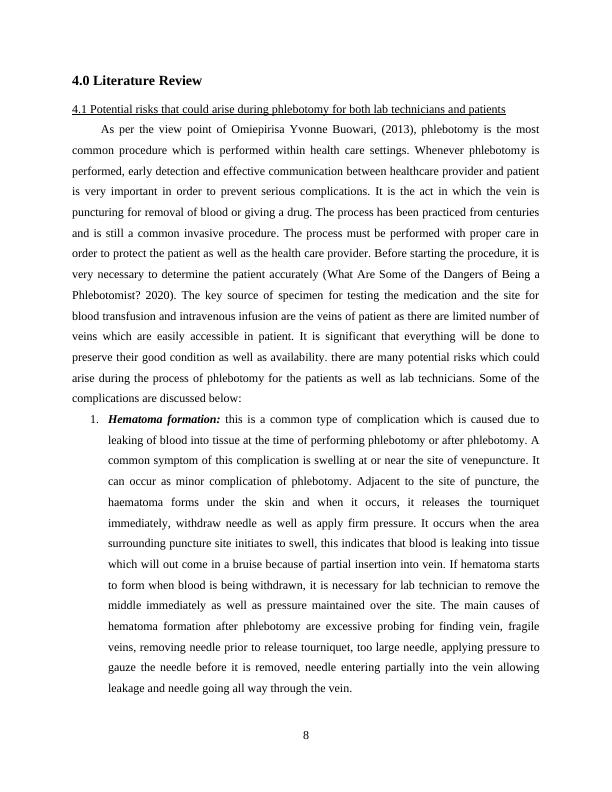
End of preview
Want to access all the pages? Upload your documents or become a member.
Related Documents
An Investigation into maintaining safe practices amongst lab technicians during phlebotomylg...
|16
|4419
|36
An Investigation into maintaining safe practices amongst lab technicians during phlebotomylg...
|30
|7058
|69
Written Reflection Assessment 2022lg...
|6
|1469
|17